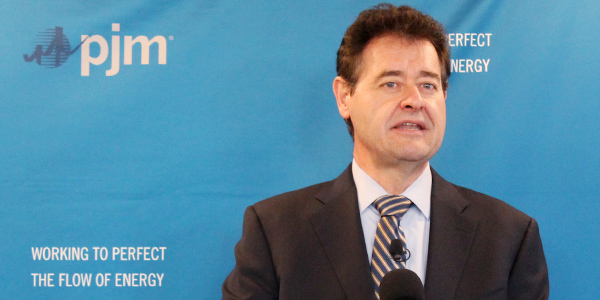By Rory D. Sweeney
The full report on fuel security in PJM’s footprint that CEO Andy Ott teased during a D.C. press conference on Nov. 1 shows that the grid is reliable in all but extreme scenarios and will remain so — as long as resources are compensated for being fuel-secure.
“This analysis demonstrates that the PJM system is reliable today and will remain reliable in the future,” says the report, which was released Monday. “Key elements such as on-site fuel inventory, oil deliverability, availability of non-firm natural gas service, location of a pipeline disruption and pipeline configuration become increasingly important as the system comes under more stress. … While there is no imminent threat, fuel security is an important component of reliability and resilience — especially if multiple risks come to fruition. The findings underscore the importance of PJM exploring proactive measures to value fuel security attributes, and PJM believes this is best done through competitive wholesale markets.”
Ott went to D.C. last month to begin the drumbeat for compensating generators on their “fuel security,” outlining proposals including valuing it in the capacity market or developing a winter reserve product in the energy market. (See PJM Begins Campaign for ‘Fuel Security’ Payments.)
The study picks up where Ott left off, noting that the proposals have been submitted in the resilience docket FERC opened in January (AD18-7). (See Don’t Rush on Resilience, Commenters Urge.)
It says the results will be used to define and value “fuel security attributes” and describes the “key variables” to maintaining reliability during extreme events as:
- Availability of non-firm gas transportation service;
- Ability of the fuel oil delivery system to replenish oil supplies during an extended period of extreme cold weather;
- Physical breaks at key locations on the pipeline system;
- Customer demand;
- Generator retirements, replacements and the resulting installed reserve margin (IRM);
- Use of operating procedures to conserve fuel during peak-winter conditions; and
- Pipeline configuration.

Study Details
The study focuses on natural gas- and oil-fired units that make up 84,823 MW of PJM’s capacity — about half of the total — but maintain less than five days of fuel on-site. It encompasses 324 “different scenarios that could occur during an extended period of cold weather” during the 2023/24 winter, including variables such as customer demand, fuel availability, oil refueling frequency, generator forced outage rates, retirements announced as of Oct. 1, new generation planned to be operational by 2023, level of reserves and natural gas pipeline disruptions.
The report provides extensive discussion to validate its assumptions, which it says are based on more than 45 years of weather data, previous studies, surveys of PJM generation owners and meetings with regulators, operators and stakeholders throughout the supply chain.
“Even in a scenario such as extreme winter load combined with a pipeline disruption at a critical location on the pipeline system from which a significant number of generators are served, PJM’s system would remain reliable and fuel-secure. While there could be reserve shortages in the extreme winter load scenarios, the grid continues to deliver electricity reliably under these extreme conditions,” the report says.
However, when combined with “escalated” assumptions that generation reserves are reduced to the 15.8% IRM, “the system may be at risk for emergency procedures and operator-directed load shed.” The retirements announced so far would create a 25.8% IRM.
Non-firm Gas
The analysis found that 16,000 MW of gas units in PJM haven’t contracted for firm service that is only interruptible by force majeure, such as a pipeline disruption. The analysis determined that a typical winter day would have 10,000 MW, or 62.5%, of those units available while an extreme winter day of high gas demand would have 0% availability from those units.
The study’s assumptions for pipeline disruptions account for up to five days of 100% reduction and at most 20% reduction for the ensuing nine days. PJM has experienced interstate pipeline outages, or “line hits,” over the past two years as the result of both pipeline corrosion and accidental third-party damage. Outages with easily identifiable sources are “typically” back in service within five days. However, non-point source issues may “require a longer outage and potential derating of the pipeline capacity.”
The scenarios studied only consider individual pipeline disruptions and don’t contemplate multiple simultaneous disruptions.
Results
Without escalated retirements, even an extreme weather event with 0% availability from non-firm units and a single high-impact pipeline disruption with limited refueling availability results in no worse than reserve shortages, according to the study.
However, of the 144 scenarios in which extreme winter load is combined with escalated retirements, 73 scenarios, or 51%, required manual load shed, which would mostly be localized to one of three areas in PJM: East, West or South. The worst scenario would result in 83 hours and 204 GWh of load shed.





